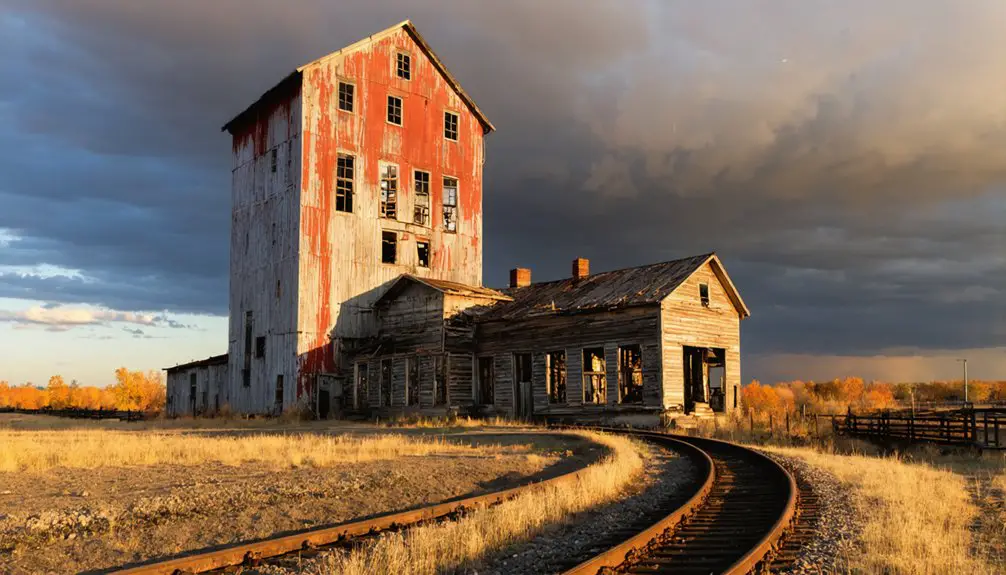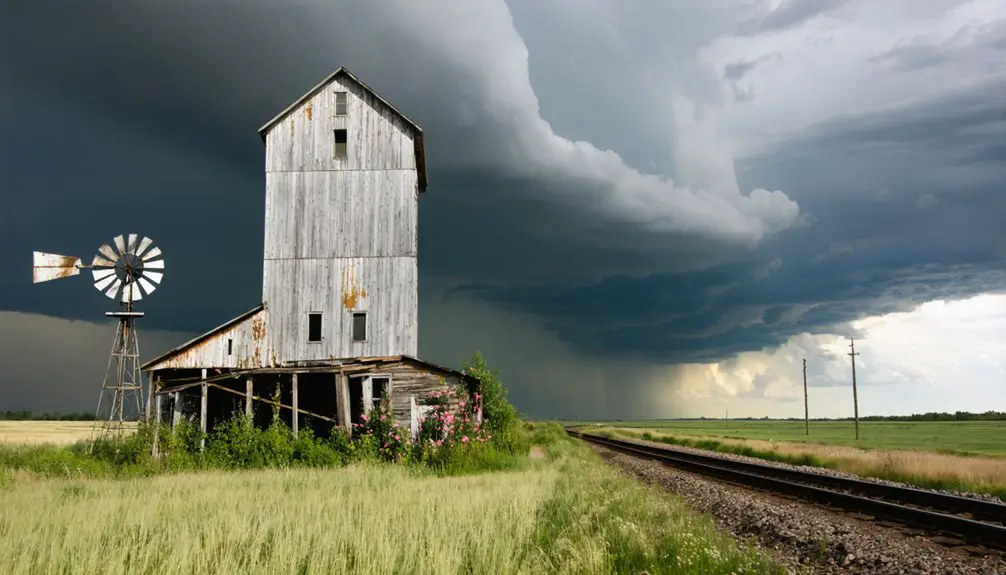You’ll find West Newton’s ghost town remains along Minnesota’s river junction, where settlers established a thriving community in 1853. The town flourished through steamboat trade and farming until devastating locust swarms (1873-1876) triggered its decline. Today, Harkin’s General Store stands preserved as a museum with 40% of its original 1870s inventory intact, offering a glimpse into the frontier settlement’s once-bustling commercial life. The site’s rich history reveals deeper tales of pioneer resilience and dramatic change.
Key Takeaways
- West Newton transitioned from a thriving river settlement to a ghost town after shifts in transportation favored nearby New Ulm.
- Harkin’s General Store, closed in 1901, stands as the last significant remnant of West Newton’s once-bustling commercial district.
- The town’s decline accelerated after the 1873-1876 locust devastation, which caused catastrophic economic losses and population exodus.
- West Newton’s post office closure in 1910 marked a definitive end to the town’s role as a communication hub.
- The abandoned townsite is now primarily remembered through Harkin Store Museum, preserved by the Minnesota Historical Society.
The Rise of a River Settlement
When settlers first arrived in West Newton during 1853-1854, they encountered a pristine wilderness along the north bank of the Minnesota River that would soon transform into a bustling river settlement. Due to multiple locations sharing the name, modern researchers must specify this as West Newton, Minnesota.
You’ll find the pioneers made tough choices, including using abandoned Indian tepees despite smallpox risks while establishing their homesteads. The strategic location at the junction of the Minnesota and Cottonwood Rivers proved essential for river navigation and early commerce.
The settlement quickly drew a diverse mix of immigrants – Germans, Scots, Austrians, and Swiss – who developed 130-acre farms along the riverbank. Alois Palmer’s ferry provided crucial transportation across the Minnesota River for the growing community.
West Newton attracted European immigrants from four nations who established farms spanning 130 acres near the river’s edge.
These immigrant contributions shaped West Newton’s character, with only a quarter of residents being native English speakers. Together, they built a thriving agricultural community that capitalized on river transport to reach wider markets.
Origins Behind the Town’s Name
The dual origins behind West Newton’s name reflect the powerful forces that shaped this Minnesota River settlement in the 1850s. In keeping with frontier naming conventions, the town’s identity merged both human pioneering spirit and technological progress.
Like many settlements facing economic uncertainty, West Newton’s eventual decline mirrored the fate of other river towns in Hennepin County.
The historical significance of the name stems from:
- James Newton, a Kentucky emigrant whose early settlement in the area earned him recognition.
- The steamboat West Newton, built in 1852, which symbolized the river’s essential role in commerce.
- The town’s post office (1862-1910), which formalized the name in federal records.
- Harkin’s General Store, which still stands as a monument to the original community.
Even as a ghost town today, West Newton’s name preserves the legacy of both its pioneering settlers and its river commerce heritage.
Economic Growth and River Trade
During the golden age of Minnesota River commerce in the 1850s, West Newton emerged as an essential trading hub, propelled by the convergence of steamboat traffic and agricultural expansion.
You’d find the 150-foot steamboat West Newton leading the charge, ferrying troops and supplies between Fort Snelling and Fort Ridgely while establishing critical trade routes.
The town’s prosperity peaked in the 1870s with a vibrant commercial district supporting river transport and agricultural exports.
River commerce and farming transformed West Newton into a bustling economic center during its 1870s heyday.
The Harkin Store, complete with its riverside grain warehouse, became the nerve center of trade operations. Local farmers relied on the river to ship their harvests and receive important supplies.
However, when the railroad bypassed West Newton in 1873 in favor of New Ulm, the town’s strategic advantage crumbled, marking the beginning of its decline.
The Devastating Locust Years
Four consecutive years of locust devastation struck West Newton between 1873 and 1876, releasing billions of Rocky Mountain Locusts that devoured everything in their path. Dry drought conditions created the perfect environment for these destructive swarms to thrive and multiply.
During this environmental catastrophe, you’d have witnessed swarms so dense they blocked out the sun, while watching helplessly as these insects destroyed your livelihood. The estimated damage across the affected regions reached over $200 million in crop losses.
The community’s survival strategies emerged through remarkable resilience:
- Harkin Store supported farmers by organizing ginseng trade with China
- Communities united in prayer, establishing Assumption Chapel
- Farmers adapted by seeking alternative income sources
- Neighbors helped each other survive, avoiding debt collections
The Harkin Store’s records tell the stark reality – sales plummeted from $3,000 to $1,750, reflecting the economic devastation.
This plague, combined with severe drought, ultimately contributed to West Newton’s decline toward ghost town status.
Harkin’s Store: A Community Lifeline
Amidst the locust devastation, one establishment stood as West Newton’s beacon of hope – Harkin’s Store. Founded in 1867 by Alexander Harkin, this combination general store and post office became the heart of community connections along Fort Ridgely Road.
You’d find more than just supplies at Harkin’s. The store buzzed with social gatherings as townsfolk huddled around the stove, sharing news and debates. During elections, you could cast your vote while checking the bulletin board for church picnic announcements. Alexander Harkin, who had immigrated from Scotland, brought his farming experience to the area in 1856.
By 1870, Harkin’s expanded to include a grain warehouse, strengthening its role as the town’s economic backbone. Visitors today can enjoy scenic river views from the store’s front porch.
When transportation shifts favored New Ulm, Harkin’s closed in 1901. Today, it’s preserved as a museum, letting you step back into frontier-era Minnesota with 40% of its original inventory intact.
Transportation and Regional Connections
While the Minnesota River carved West Newton’s destiny as a frontier outpost, the town’s transportation network wove together multiple lifelines that defined its rise and fall.
You’ll find West Newton’s regional connectivity was built on a sophisticated web of river, road, and ferry routes that energized frontier commerce in the 1850s-60s.
The town’s major transportation advantages included:
- The steamboat *West Newton* running supplies to Fort Ridgely and Sioux Agencies
- Strategic position along the Fort Ridgely Road linking military posts
- A crucial Minnesota River ferry crossing point
- Direct water access for agricultural shipping
Yet when the railroad bypassed West Newton for New Ulm in 1873, the town’s transportation advantage vanished.
The railroad’s arrival in New Ulm marked West Newton’s decline, erasing the river town’s strategic importance in a single stroke.
Without rail connections and declining river traffic, West Newton’s role as a regional hub faded into history.
Notable Residents and Local Leaders

Among West Newton’s early frontier leadership, you’ll find James Newton from Kentucky, whose presence partially inspired the town’s name and helped establish its initial settlement patterns.
Alexander Harkin emerged as a central community figure through his general store operation from 1871, serving as both merchant and postmaster while helping farmers survive economic hardships through innovative trading solutions.
The town also produced John Hubert Peschges, who rose from his local roots to become the second Roman Catholic Bishop of the Diocese of Crookston, representing West Newton’s contribution to broader regional religious leadership.
Early Frontier Settlement Leaders
When West Newton was first established in 1852, several key figures emerged as instrumental leaders in shaping the frontier settlement’s early development.
Like the nearby town of Minneiska, West Newton was one of the earliest settlements in Wabasha County, emerging as a commercial hub along the river.
These pioneers relied heavily on subsistence hunting and fishing while trading with steamboat stewards for essential supplies during the initial settlement period.
Facing pioneer challenges and complex settlement dynamics, these early leaders worked to transform the wilderness into an organized community.
- Abner Tibbetts and B.C. Baldwin purchased the initial property and collaborated with Read and Reppe to lay out the town site in 1853.
- James Door Sr. and his son Simon established essential homesteads in 1855, paving the way for further expansion.
- C.H. Huddleston served as the first township chairman and clerk, while J.W. Horner and Mark Grey maintained order as justices of the peace.
- Alois Palmer operated the significant Palmer Ferry from 1859-1867, connecting West Newton to other settlements and carrying mail to Fort Ridgely.
Harkin’s Community Leadership Role
As a prominent figure in West Newton’s development, Thomas Harkin established himself as an influential community leader through his operation of Harkin’s General Store and extensive civic engagement. His store served as more than just a business – it became an essential community gathering spot where residents could trade goods, share news, and strengthen social bonds.
Like Minnesota businessman James J. Hill, Harkin demonstrated remarkable entrepreneurial vision in developing vital commercial infrastructure for his community. His leadership fostered connections between settlers and travelers while supporting river trade networks significant to West Newton’s economy.
You’ll find Harkin’s influence extended far beyond commerce. He shaped local governance through his advocacy for critical services, including the post office that operated from 1862 to 1910.
Today, his legacy lives on through his preserved general store, listed on the National Register of Historic Places, offering a window into how early Minnesota communities thrived through small-business leadership.
Bishop Peschges’ Local Origins
The rich legacy of West Newton extends beyond its commercial ventures into spiritual leadership through Bishop John Peschges, who emerged from this Minnesota River settlement in 1881.
His rise from this small pioneer community to becoming the second Bishop of Crookston exemplifies the spirit of local religious influence in shaping Minnesota’s Catholic heritage.
Bishop Peschges’ Legacy includes these notable achievements:
- Ordination as a Roman Catholic priest in 1905, serving the Archdiocese of Saint Paul and Minneapolis
- Leadership within the Diocese of Winona during his early ministry
- Appointment as Bishop of Crookston in 1938, where he served until 1944
- Preservation of West Newton’s historical significance through his documented ecclesiastical career, connecting this ghost town to broader regional Catholic development
Legacy and Historical Landmarks

You’ll find Harkin Store standing as West Newton’s most significant surviving landmark, preserving its original 1867 merchandise and serving as a museum that tells the story of pioneer commerce along the Minnesota River.
The town’s postal service infrastructure, which operated from 1862 to 1910, marked West Newton as a crucial communication hub during Minnesota’s territorial expansion.
The historic river crossing site near the settlement continues to remind visitors of West Newton’s strategic location and its role in early Minnesota transportation networks.
Harkin Store’s Enduring Impact
Standing as a symbol of Minnesota’s pioneer spirit, Harkin Store remains one of the most significant historical landmarks from the state’s early settlement period.
As the last physical reminder of West Newton’s vibrant past, this preserved general store offers you a genuine window into 19th-century rural life.
You’ll discover how this crucial community hub shaped local development through:
- Serving as the central gathering spot for commerce, news exchange, and social activities
- Housing the town’s post office until 1901, when Rural Free Delivery arrived
- Facilitating essential trade along Fort Ridgely Road and Minnesota River routes
- Preserving over 40% of its original merchandise, providing authentic insights into pioneer retail
Today, the Minnesota Historical Society maintains this cultural treasure, allowing you to experience firsthand the atmosphere of early frontier commerce.
Postal Service Infrastructure Remains
Beyond Harkin Store‘s role as a commercial hub, West Newton’s postal infrastructure played a defining part in the town’s development from 1862 to 1910.
You’ll find evidence of postal service evolution in the building’s transformation from a modest log cabin to a larger frame structure, reflecting the growing needs of the community. The site, now preserved as a historical landmark, tells a compelling story of how community interactions centered around this multipurpose space.
Inside Harkin’s General Store, you can still see where townsfolk once gathered to collect mail, purchase goods, and even cast their votes during elections.
When transportation routes shifted away from the Minnesota River, the post office’s decline mirrored West Newton’s fading prosperity, leaving behind a testament to rural Minnesota’s early postal history.
River Crossing Historical Site
While steamboats churned along the Minnesota River in the late 1800s, West Newton emerged as a vital crossing point that shaped regional commerce and settlement.
You can still explore this historic riverboat stop where the WEST NEWTON first passed in 1853, transporting troops to establish Fort Ridgely.
At this significant river crossing, you’ll discover:
- The original landing site where steamboats once docked
- The preserved Harkin Store, containing 40% of its 1870s inventory
- The deep valley carved by the River Warren, stretching 250 feet down
- Cedar Rock WMA’s elevated vantage points overlooking the crossing
Despite settlement challenges like grasshopper plagues and economic downturns, West Newton’s riverboat history lives on through the preserved store and landing site, offering you a glimpse into frontier Minnesota’s pioneering spirit.
Frequently Asked Questions
What Happened to West Newton’s Remaining Residents After the Town Was Abandoned?
You’d think remaining families vanished into ghost stories, but they actually relocated to thriving nearby towns like New Ulm, seeking better opportunities while some dispersed throughout Nicollet County and Minnesota’s urban centers.
Are There Any Surviving Photographs of West Newton During Its Peak Years?
You won’t find any photographs from West Newton’s peak years in historical archives. The only surviving photographic evidence shows later periods, mostly featuring Harkin’s Store after the town’s decline.
What Native American Tribes Originally Inhabited the West Newton Area?
You’ll find the Dakota people were the primary inhabitants, with Ojibwe influence in the region. Native history shows both tribes valued this area’s tribal significance along Minnesota’s essential waterways.
Did Any Structures Besides Harkin’s Store Survive to the Present Day?
You’ll find just two architectural remnants through historic preservation: Harkin’s General Store and the adjacent Harkin family home. These are the only surviving structures from the town’s original buildings.
Were There Any Schools or Churches Established in West Newton?
Like a fading footprint in time, you won’t find evidence of school establishment or church history in historical records. Neither schools nor churches were documented, though religious leaders had connections to the area.
References
- https://www.wikiwand.com/en/articles/West_Newton
- https://en.wikipedia.org/wiki/West_Newton
- https://www.mnhs.org/harkinstore/learn
- https://www.carvercountyhistoricalsociety.org/ghost_towns.php
- https://npgallery.nps.gov/GetAsset/cd8b380f-5eb0-420f-9047-1ef1ab5c451a
- https://www3.mnhs.org/usdakotawar/stories/share-your-story/2784
- https://www.dnr.state.mn.us/state_trail/virtual_tour/minnesota_river/snapshot.html
- https://sites.rootsweb.com/~mnwabbio/3ch18.htm
- https://www.minnesotahistory.org/post/a-complete-guide-to-the-ghost-towns-of-hennepin-county
- https://kids.kiddle.co/West_Newton



